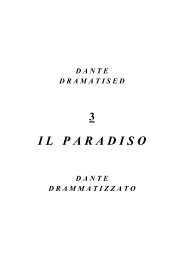Create successful ePaper yourself
Turn your PDF publications into a flip-book with our unique Google optimized e-Paper software.
10. PRESENT & PAST (occasional): A character, usually Dante, describes a scene in English as it happens,<br />
then Dante versifies it as having happened.<br />
Greyed words interpret/translate for the benefit of the actors but are not spoken. They also show sections of the LA<br />
DIVINA COMMEDIA – English-only for reasons of space – which are omitted from the dramatisation. Future versions<br />
of the dramatisation might omit included passages/characters and restore greyed ones.<br />
There are many passages included which a director might cut, starting with those which are shown this way.<br />
The dramatisation presents Dante’s lines in his order (with very few exceptions.). A handful of them are spoken by<br />
a person other than the one nominated by Dante.<br />
Only about 2,100 lines of Dante’s 14,233 lines are not quoted or used for the scene, music and action.<br />
Approximately 2575 of the spoken lines or part-lines are Italian.<br />
LA DIVINA COMMEDIA is the Giorgio Petrocchi edition. (Permission may need to be obtained.)<br />
The English prose used is mostly from the translation by A.S.Kline. In some places it is abridged, or, for the sake of<br />
natural speech, freed from his adherence to Dante’s phrasing. Underlined words replace Kline’s. Underlining also<br />
marks words based on Notes, and works not by Dante. Longer segments not by Dante are not underlined. There are<br />
approximately 700 lines or part –lines added to Dante’s in the dramatisations.<br />
Most of the Notes are by Kline.<br />
DIALECTS<br />
The characters should be individualised with accents or an occasional word or phrase appropriate to to their region,<br />
time and status; firstly because regionality was very marked in Dante’s time and work; secondly because modern<br />
Italians viewing the dramatisation would feel a closer connection to it.<br />
See L’INFERNO SCHEME: CHARACTERS BY PLACE.<br />
Other characters may contribute Italian words, phrases or lines to the dramatisation, but not completed verses, the<br />
only exceptions being Beatrice (who knows everything), and Guinicelli [PUR C26 73].<br />
Consequently, most of the non-English is spoken by Dante and Beatrice. Some words of the other characters could<br />
be composed in prose – Dantean Italian or dialect – for versification by Dante and interpretation into English.<br />
STAGES & SETS<br />
The motif of each dramatisation is 3 sets of 3 steps: 3 for its beginning, middle & end; 3 for the Trinity; 3 for Faith,<br />
Hope & Love; 3 for the groups of planetary orbits; 3 for the Hierarchies of Angels; 3 for the orders within each<br />
hiera rchy; 3 for musica mundana, humana & instrumentalis; 3 for the Graces; 3 for 1/3 or √ of 9, Beatrice’s<br />
number; 3 for terza rima; 3 for the canticles of the DIVINE COMEDY and their 33 Cantos (+ 1 Canto introduction for<br />
L’INFERNO) etc. IL PARADISO has a triptych as well.<br />
Three steps means the lower level, 1 step and the upper level, as shown in the introduction to each canticle. Each<br />
step is identified by a rectangle above it.<br />
Characters speaking terza rima may sometimes fit it to their passage up or down steps. For example, one line or<br />
one verse per step.<br />
CHARACTERS AND DRESS<br />
The spirits of L’INFERNO and IL PURGATORIO are prisoners, and dressed anonymously. Those in IL PARADISO are<br />
free and have been given back their clothes.<br />
Dante is dressed as in the familiar pictures. He has a very long, tasselled cord wrapped round his waist most of the<br />
time, but he does not get his laurel wreath until the end of the COMMEDIA.<br />
He carries a book, not his DIVINE COMEDY but a workbook for it, probably composed of wax tablets or slates. The<br />
stylus is kept in the spine.<br />
Virgil is also dressed as in the pictures, including the laurel, and his book is the Aeneid and other works.<br />
Beatrice’s book is a Bible. Her small role in L’INFERNO expands in the later canticles. Beatrice’s smile devastates<br />
Dante. He and the audience should not be exposed to it (i.e. .shown it in full face) unecessarily.<br />
All characters with books have a holder on their chests and/or backs to free their hands if necessary.<br />
We are so used to pictures of the grand Dante we forget that he was not quite 35 years old when the action of the<br />
Commedia took place, in 1300.<br />
See L’INFERNO SCHEME: CHARACTERS BY PLACE.<br />
THE MUSES See SCHEME: PROGRAMME mock-ups for Muse table.<br />
Different accounts of the Muses assign them different symbols, domain & dress (including crowns).<br />
The audience does not hear their domains named in the dramatisation so there is no problem with who is who.<br />
Each Muse carries a white book with her symbol on it. The masks may be found by research or designed.<br />
Naturally, they are not the Tragedy / Comedy clichés of so many playbills. The Muses are dressed identically, in<br />
white, to let them serve in both pagan and Christian capacities. Calliope, the eldest sister, may be distinguished by<br />
her height and/or a gold band on her head. Terpsichore is the smallest Muse and Euterpe, perhaps, the 2 nd smallest.<br />
Polyhymnia (nearly?) always wears her pensive look and has a finger at the mouth. When the Muses sing Christian<br />
music on stage they show the back of their books.<br />
All the Muses’ props (bows, arrows, boats etc.) are imaginary – of course. The only exceptions are the books they<br />
carry and and Euterpe’s flute in L’INFERNO.<br />
4



